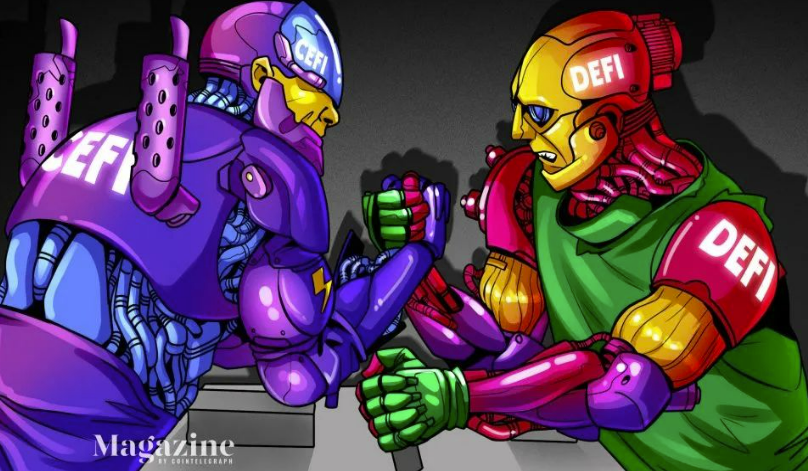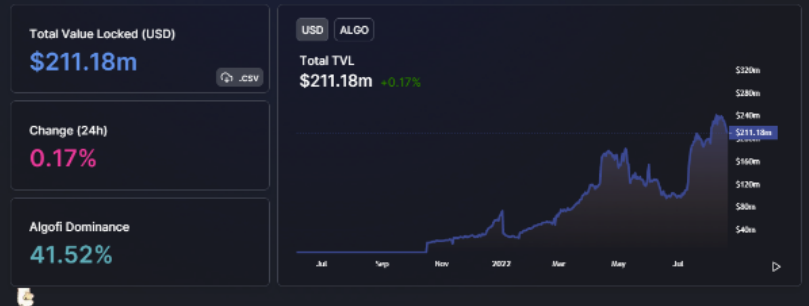Original link: https://www.hellobtc.com/kp/du/09/4003.html
Author: Zhiyuan Sun / Compilation: Huo Huo / Source: Vernacular Blockchain

Author | Zhiyuan Sun
Compile | Fire
Produced | Vernacular Blockchain (ID: helloBTC)
CeFi storms, DeFi steals money, the financial world is full of risks. With the global trend of turmoil and the variety of crypto market participants, how institutions and users manage their assets has become a difficult problem.
Today, the vernacular blockchain brings you a compiled article, which takes you to understand the current status and future of CeFi and DeFi.
The following is the compiled text?
01
DeFi VS. CeFi, who is better?
Sunny Aggarwal of Osmosis DEX said: “The failure of a bank like Celsius is a testament to how badly centralized, opaque finance is!”
Due to poor risk control, the credibility of centralized financial platforms has taken a huge hit, but decentralized financial protocols have not been spared!
In November 2021, Zhu Su, co-founder and chief investment officer of hedge fund Three Arrows Capital (3AC), became a big player in the CeFi industry. By then, Zhu Su and his friend Davies used the fund’s assets to buy more than $400 million worth of ETH, making them one of the largest cryptocurrency holders in the world.
With the development of the bull market in the crypto industry, many people who want a piece of the pie come here , and that is when a lot of money pours into the Singapore-based 3AC. After all, all investors want their job to be to make transfers and remittances, get rich returns through the hands of “professionals”, and then sit back and relax, right?
But just eight months later, both Jusu and Davies are in hiding! There is an estimated $2.8 billion hole in the balance sheet as a British Virgin Islands court ordered the liquidation of 3AC. The company’s bankruptcy dealt a major blow to the development of the CeFi industry, and just like that, hundreds of billions of dollars in market value disappeared out of thin air.
So, DeFi or CeFi who will emerge stronger during these turbulent times? Or could there be some kind of hybrid of the two in the future?

DeFi VS. CeFi Contest
As the inside bear market intensified in May, 3AC proved horribly wrong in making a series of highly leveraged directional bets, losing potentially all of its investors’ capital. 3AC has taken large loans from all the big CeFi lenders – Voyager, BlockFi and to a lesser extent Celsius – which also puts them all at risk.
According to reports, crypto brokerage Voyager Digital provided 3AC with $665 million for trading purposes, and it was not helpful at 3AC to issue a default notice, so it was also forced to file for bankruptcy. Genesis also announced it would cut one-fifth of its workforce and replace its chief executive after a $2.4 billion loan to Three Arrows Capital. BlockFi loses heavily after liquidating 3AC; Finblox closes withdrawals; Derebit files for liquidation; Blockchain.com suffers $270 million loss and lays off 25% of its staff.
Luckily Celsius was not directly affected by 3AC as it only had $75 million in outstanding loans to the fund, however, the impact of the previous Terra crash continued, with falling cryptocurrency prices and a bank run causing its net worth to drop to – $2.85 billion and was forced to indefinitely halt withdrawals from more than 1.5 million customers. It is currently trying to get out of bankruptcy by facilitating asset flows through various transactions.
02
How is DeFi performing?
Decentralized finance, or (DeFi), has fared much better in terms of coherence and has generally been trending upwards. The thriving state of cryptocurrencies, such as peer-to-peer lending, DEX exchanges, and liquid staking, led many cryptocurrency enthusiasts to believe that the world is at the gates of a new decentralized finance revolution.
Indeed, in the space of two years, TVL (Total Value Locked) in DeFi projects has grown from zero to over $300 billion. Even traditional financial institutions (TradFi) who are skeptical of blockchain, such as the Bank for International Settlements, have praised DeFi for the technological innovation it brings.
However, investor confidence was hit by Terra’s debacle and was further destroyed by the ongoing hacking campaign. Because in the second quarter of 2022, $678 million was lost due to hacking. Malicious actors such as the North Korean-backed Lazarus Group have wreaked havoc with clever new methods to hack into smart contracts and steal user funds. Axie Infinity, a popular NFT monster fighting game whose Ronin cross-chain bridge lost $612 million in a Lazarus attack earlier this year.
Undoubtedly, the opacity of investor funds and poor risk management and lack of accountability have seriously damaged CeFi’s reputation. But DeFi’s precipitous decline also surprised many cryptocurrency investors who initially didn’t support custodial funds.
The cryptocurrency bear market has caused the value of some DeFi tokens to drop by more than 90% in a few months, while some have disappeared entirely. Even reputable “blue-chip” projects, such as the lending protocol Aave, the decentralized trading platform Uniswap, and the stablecoin liquidity platform Curve, cannot protect their tokens from bloodbath, and a 60%–70% drop is not bad .
Lost money due to mistakes, flawed code and security breaches has severely dented confidence in the nascent industry. The recent sanctions on Tornado Cash have also reignited concerns about the decentralization of Ethereum. So, how likely is it that crypto enthusiasts’ vision of a decentralized future will recover?
-
First, ensure the safety of your funds
Fortunately, smart developers and savvy project leaders are already addressing DeFi’s shortcomings, learned from bears. Immunefi is a bug bounty and security services platform that has paid out over $40 million in bounties to white hat hackers. It currently provides bug discovery bounties for over 300 DeFi and crypto projects with an estimated $100 billion in user funds.
Mitchell Amador, CEO of Immunefi, said there is a severe lack of security expertise in the DeFi space, and this lack of deeper knowledge has led many developers to start a business by simply copying and pasting code from other projects.
So when there is a vulnerability in one of the projects, there are also vulnerabilities in the other projects. This is a vulnerability specific to encryption rather than centralized Web2 companies. He also said, “The Web3 industry is not the same, as a smart contract bug could mean a permanent loss of funds.”

Immunefi’s bounty list. Source: Immunefi
Because billions of dollars of user funds are locked in smart contracts, black hat hackers can study these contracts, discover their vulnerabilities, and exploit their transparent, open-source nature to attack and steal. Additionally, some state-backed hacking groups, such as the Lazarus Group from North Korea, also dedicate significant resources to protocol looting.
Problems in particular focus on cross-chain bridges, which tend to have more moving parts than regular decentralized applications, and are also full of complexity and lack of standardization. The locked state of large amounts of funds also makes them “ideal” targets for hackers.
The bounties issued by Immunefi and the protocol encourage white hat hackers to “legitimately” discover protocol vulnerabilities and help resolve them. In June, Ethereum bridging and scaling solution Aurora paid a $6 million bounty to ethical security hacker pwning.eth via Immunefi. If a malicious attacker decides to exploit the vulnerability, the protocol could suffer a loss of $200 million.
Not all cross-chain bridges are equally vulnerable. Sunny Aggarwal, co-founder of Osmosis DEX, said that such hacks mostly occurred on bridges connected to the Ethereum Virtual Machine (EVM) rather than the Inter-Blockchain Communication Protocol (IBC) running on Cosmos.
“Major bridge hacks remind victims of the fact that bridges are too fragile to host large sums of money at this stage of their life cycle. Nearly 50 blockchains use IBC every day in an ecosystem with over $1 billion in assets Made over 10 million IBC transactions.”
“It’s a completely trustless system,” Aggarwal commented. “I don’t think the future of DeFi has ever looked brighter. Protocols like Terra Luna were positioned for binary success; it was either a failure or a big success due to its extremely risky dual-token switching design. But in the end, Terra’s collapse Proving that the IBC is working as promised, and a useful stress test of Osmosis as a whole.”

2021 Lisbon Cosmoverse Conference. Source: Cosmos
For Aggarwal, the whole point of the industry is to allow experiments like this to happen so that builders and researchers in the field can continue to iterate, integrating what works and blacklisting what doesn’t. “That way, over time, the technology will eventually improve in boom and bust cycles.”
03
Why can’t you have both fish and bear’s paw?
CeFi and DeFi will basically not keep pace with each other, so the future is likely to be a combination of the two.
SEBA Bank is a crypto-first custodian bank licensed by the Swiss Financial Markets Authority (FINMA). Matthew Alexander, head of digital enterprise finance and asset tokenization at SEBA Bank, told related magazines that if loan interest rates are comparable to or better than TradFi, more traditional financial institutions will want to participate in decentralized finance, which will attract more liquidity ecosystems system.
Daniel Oon, head of DeFi at Algorand, also believes that combining DeFi and TradFi concepts has great potential, but the focus still needs to be on decentralization. “I would say that the industry will witness new growth in the next year or so. Currently, services such as borrowers are over-collateralized. The move to decentralized trust-backed loans could have a huge impact in the future.”

The TVL of the Algorand blockchain is also growing in a bear market. Source: DefiLlama
Theoretically, the concept of decentralizing borrowers’ partially collateralized deposits, rather than fully collateralized deposits, could be aided by the transparency inherent in DeFi. Unlike CeFi products, DeFi protocols typically update applicable profits, losses, total value locked, token emissions, and project reserves in real-time.
“This transparency is in stark contrast to the opacity we are witnessing in CeFi, which is a major contributing factor to the crashes, troubles and scandals that many CeFi products have experienced during market downturns,” SEBA’s Alexander said.
Institutional investors are often banned from accessing some financial products in DeFi due to strict policy regulations. But custodians such as SEBA Bank are helping to bridge the gap. Cryptocurrencies held by SEBA can be traded with fiat currencies 24/7 while earning DeFi benefits. What’s more, the Swiss Deposit Guarantee Scheme also provides security for fiat funds in the accounts that clients use for trading.
04
Let’s get DeFi up together
For true believers in decentralization, though, nothing beats pure DeFi.
Marvin Bertin, partner and chief scientific officer of Genius Yield, a DeFi protocol running on the Cardano blockchain, believes that a decentralized financial system will be more inclusive. Bertin pointed out that the profits generated by DeFi protocols usually go to the users themselves:
“Take a traditional bank as an example. Customers deposit their fiat currency into an account where they earn 0%–1% interest. The same bank then lends out customer funds at 10x or more. Many people using these institutions are Because they have no choice. DeFi can allow customers to lend their savings to other customers, essentially making a profit themselves, rather than handing them over to the big CeFi institutions.”
Ironically, of course, this is very similar to the explanation that Celsius founder and CEO Alex Mashinsky often uses to explain how the protocol returns such high returns to depositors. In January 2021, he said in an interview, “DeFi, CeFi, whatever you call it. Everyone is chasing yield because central banks and commercial banks just don’t pay anything for your money.”
“What we’re doing is basically using some of the best ways Wall Street has ever created to earn yield or extract value from capital,” he added.
Hopefully the transparent and truly decentralized platform will avoid a similar fate to the risky, centralized and now bankrupt Celsius.

Magazine Profiles Founder in ‘The Adventures of Creative Alex Masinski’
Another advantage of DeFi, Bertin said, is that many people who have been excluded from the traditional venture capital circle because they don’t have a high enough net worth can come in. He said it was mandated by governments in many developed countries and provided privileges for the wealthy. But in DeFi (at least in theory), anyone with an internet connection can access financial services, breaking the barriers of traditional rules.
DeFi offers new and innovative financing methods, and some protocols even attempt to find ways to avoid investment risks. Zug-based Genius Yield managed to raise its own seed funding through a community-based Initial Stake Pool Offering (1SPO) on Cardano.
In 1SPO, a new project that needs funding first opens a public stake pool. Cardano users then entrust them with ADA Token rewards of 4%–5% Annual Yield (APY) in exchange for the project’s native Token.
Unlike traditional fundraising mechanisms, there is no risk to the delegator because it is just a delegation and no funds are exchanged. Other things being equal, the maximum loss is the 4%–5% opportunity cost gained through ADA staking when the project goes bankrupt.

Genius Yield ISPO Dashboard. Source: Genius Yield
However, risk is a relative concept: how to balance the possibility of a centralized service crashing against the risk of smart contracts being exploited? SEBA Bank’s Alexander noted that DeFi is more likely to fall victim to disruptive hacks than CeFi, but it also offers other tangible benefits. “It really depends on what users value most, such as openness, transparency, permissionless, security, risk, compliance, etc.,” he said. According to Bertin of Genius Yield, the core reason why DeFi will outperform CeFi is self-regulation. Cryptocurrencies can be kept in personal wallets where only users have private spending keys.
“You have complete control over your funds – period. Your funds cannot be seized or spent by any other party,” he said.
In contrast, CeFi institutions such as banks or centralized exchanges can freeze, seize or restrict your access to your funds at any time. Self-custody also protects users from the risk of bankruptcy of centralized entities. This year, when celsius and Voyager went bankrupt, the funds of customers with millions of dollars worth of cryptocurrencies on those platforms were frozen.
“These customers could lose all their money, not by their own decisions or mistakes, but by the people who run these CeFi companies,” he said. On the other hand, in DeFi there is no avenue for reversing transactions or recovering stolen funds, and if you lose your mnemonic phrase, it means you lose your funds forever. Therefore, some people will choose to trust centralized institutions, while others will choose to trust themselves.
05
summary
So while CeFi and DeFi both have their place, Genius Yield co-founder and association president Laurent Bellandi is more bullish on the future of DeFi. “While there are many unknowns, factors suggest that this area could become a major force in the financial world,” he said.
“As the market recovers, laws are enacted, trust is restored, and more people realize the potential of DeFi products and services, the scene will only attract more capital.”
Statistics seem to bear this out. As of July 2022, capital investment in the cryptocurrency space reached $31.3 billion, surpassing the full-year 2021 total. As of August 25, the total value locked in DeFi protocols per DefiLlama was $61.55 billion. In fact, this is half the number of TVLs in August 2021, but several orders of magnitude higher than in August 2020. Despite the setback a while ago, DeFi’s trajectory appears to be very upward.
*Note:
> White hat hackers are like shields. They understand hacking techniques and choose to use technology to protect network security. After discovering vulnerabilities, they will provide all results to relevant companies to help them improve their products.
> Contrary to white hat hackers, black hat hackers are often referred to as “hackers” or “hackers”. They often use their own technology to steal other people’s resources on the Internet or crack the software that is charged for profit.
> Cross-chain communication protocol IBC is a reliable and secure inter-module communication (interoperability) protocol that enables reliable cross-chain transmission, verification and sequencing of data.
Original link: https://ift.tt/bxSG6NU
Original title: DeFi vs. CeFi: Decentralization for the win?
Original author: Zhiyuan Sun
Compilation: Fire
This article is reprinted from: https://www.hellobtc.com/kp/du/09/4003.html
This site is for inclusion only, and the copyright belongs to the original author.